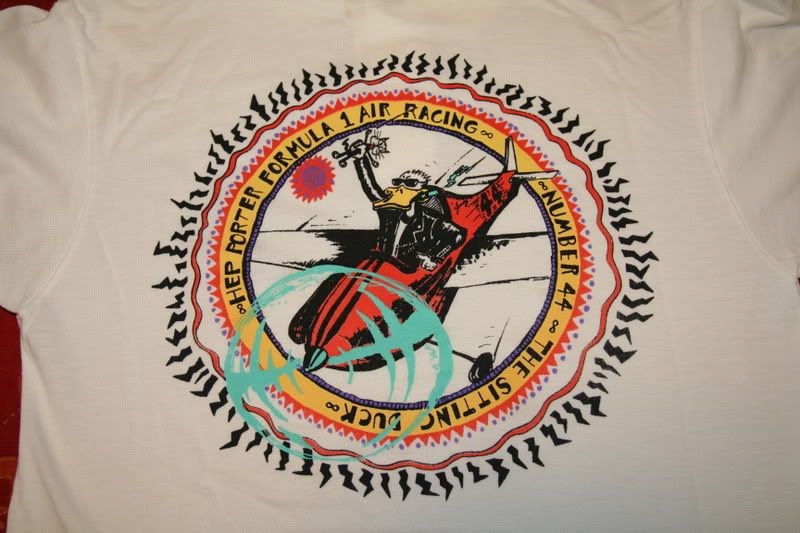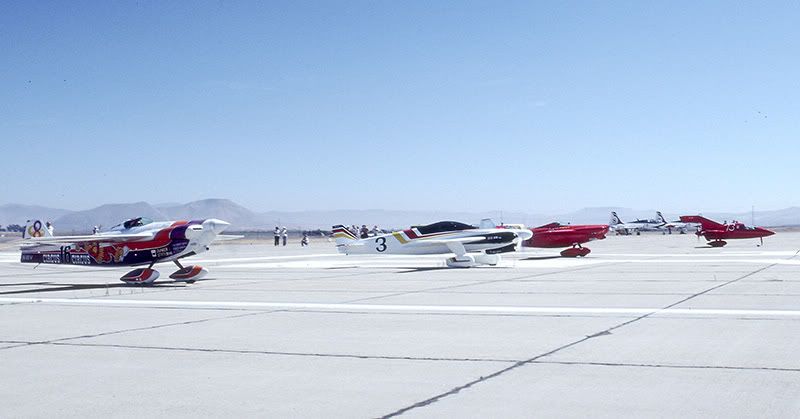Mon Feb 18, 2008 9:29 pm
Good for Hep! He is one of the sport's really good guys. He may have a Gold Race ride this year too...
That whole airplane was really beautifully built.
That whole airplane was really beautifully built.
Mon Feb 18, 2008 9:48 pm
retroaviation wrote:Man, it just keeps gettin' better.......I just spoke with the guy I bought the tail from, Hep Porter, and he told me that he's now just going to rip up my check for the tail and just consider himself a sponsor of the project! He also just remembered that he's got what he thinks to be the forward attach bracket for the horizontal and vertical fins, which I need.
This is such a cool and fun project!
Gary
Hep is a great guy, we used to have alot of fun in the IF1 hangar.
Mon Feb 18, 2008 9:56 pm
So I went to my air-racing clothes closet and guess what I find.......
notice the kitty cat in the ducks hands?

notice the kitty cat in the ducks hands?

Mon Feb 18, 2008 10:39 pm
bdk wrote:How many ribs and spars in that horizontal? I'm curious how it was made so thin too!
I'll take a closer look tomorrow and get you an answer. I'll also snap a few close up pictures of it for you. The workmanship on this thing is quite nice indeed.
Gary
Mon Feb 18, 2008 10:43 pm
Now that is a great t-shirt! I can see why Jim was displeased...
Mon Feb 18, 2008 10:57 pm
Neal Nurmi wrote:Now that is a great t-shirt! I can see why Jim was displeased...
Jim and I had a very professional relationship as he did with the other pilots. In other words, he was NEVER the party type when I new him, and he expected me to not party also.
I liked to have fun (and make his airplane go fast by the way) so I always made great friendships with the other crews and pilots.
Hep and I became pretty good freinds and had a good sparing type relationship during the races.
Tue Feb 19, 2008 12:33 am
This start shot from 1980 has the original Shoestring on the left, #44 (the second Shoestring) second from the right, Jim Miller far right, and John Parker of current Thunder Mustang fame. Truly a bunch of historic Championship airplanes and pilots...


Tue Feb 19, 2008 8:18 am
AWESOME T-SHIRT!!!!!!  Poor Mister Kitty!
Poor Mister Kitty! 
Tue Feb 19, 2008 4:34 pm
BDK, here are some closer pictures of the tail section for you. It's kind of tough to specifically say the exact number of ribs on the horizontal stabilizer, due to the way the center section of it is built. You can see that there is some sort of structure (that seems quite substantial) in the center of the stabilizer, but I can't say for sure if they're technically ribs, or some other form of structure. Outboard of the attach points, you can see that there are three ribs...an inboard, a center rib, and an outboard rib. In addition, there is a main spar (center), a rear spar, and a support stringer towards the leading edge.

The elevators and rudder on this thing are about as slick an installation as I've seen on ANY airplane! As you can see in this picture of one of the elevators, is an extemely small amount of drag, as it's tucked into the stabilizer nice and tight...

This is accomplished by utilizing steel dowel pins on the elevators (rather than having to install cutouts to install bolts), which simply slide into place on the receptacles firmly mounted to the stabilizer. The elevators are held in place and to one another by a bracket, which also doubles as the bellcrank and counterweight, in between the two of the elevators. The trailing edge of the stabilizer has been formed to exactly match the contour of the elevators for the least amount of drag possible.....


The horizontal stabilizer itself is only something like 1"-1.25" at it's thickest point. Both it and the vertical fin are each made of one piece of skin that has been formed into shape. How they riveted this thing together, especially in such a nice fashion, is beyond me. Simply fantastic workmanship!
Both it and the vertical fin are each made of one piece of skin that has been formed into shape. How they riveted this thing together, especially in such a nice fashion, is beyond me. Simply fantastic workmanship!

Gary

The elevators and rudder on this thing are about as slick an installation as I've seen on ANY airplane! As you can see in this picture of one of the elevators, is an extemely small amount of drag, as it's tucked into the stabilizer nice and tight...

This is accomplished by utilizing steel dowel pins on the elevators (rather than having to install cutouts to install bolts), which simply slide into place on the receptacles firmly mounted to the stabilizer. The elevators are held in place and to one another by a bracket, which also doubles as the bellcrank and counterweight, in between the two of the elevators. The trailing edge of the stabilizer has been formed to exactly match the contour of the elevators for the least amount of drag possible.....


The horizontal stabilizer itself is only something like 1"-1.25" at it's thickest point.

Gary
Tue Feb 19, 2008 5:48 pm
mustanglover, I'm sorry to tell you that the Sitting Duck logo is no longer on the tail surfaces for Another Solution.....

However, did I mention that I was able to save the artwork from one side for you?

Actually, Hep gets first dibs at the artwork. But if he decides that he doesn't want it, I would happily trade it to you for a bit of monetary sponsorship to the Another Solution project fund.
Gary

However, did I mention that I was able to save the artwork from one side for you?

Actually, Hep gets first dibs at the artwork. But if he decides that he doesn't want it, I would happily trade it to you for a bit of monetary sponsorship to the Another Solution project fund.
Gary
Tue Feb 19, 2008 7:58 pm
retroaviation wrote:mustanglover, I'm sorry to tell you that the Sitting Duck logo is no longer on the tail surfaces for Another Solution.....
However, did I mention that I was able to save the artwork from one side for you?
Actually, Hep gets first dibs at the artwork. But if he decides that he doesn't want it, I would happily trade it to you for a bit of monetary sponsorship to the Another Solution project fund.
Gary
You tell Hep to give me a call if he wants!!! (I will PM you my phone number)
He already donated, I will hep (
Tue Feb 19, 2008 8:18 pm
Start the bidding war. 
Tue Feb 19, 2008 10:21 pm
ebutner wrote:Start the bidding war.
Please no bidding wars.
That is a great recent bit of IF1 history. If hep wants it, it is his for sure.
But, if not, I will gladly make a donation to Gary's racing/restoring fund.
Wed Feb 20, 2008 11:03 am
Just kidding about the bidding war stuff. Yes this is a wonderful bit of F1 history. I think it's great he got it off there so cleanly. Can't wait to see him rounding the pylons in her!!!!
Wed Feb 20, 2008 12:31 pm
Looking good Gary!